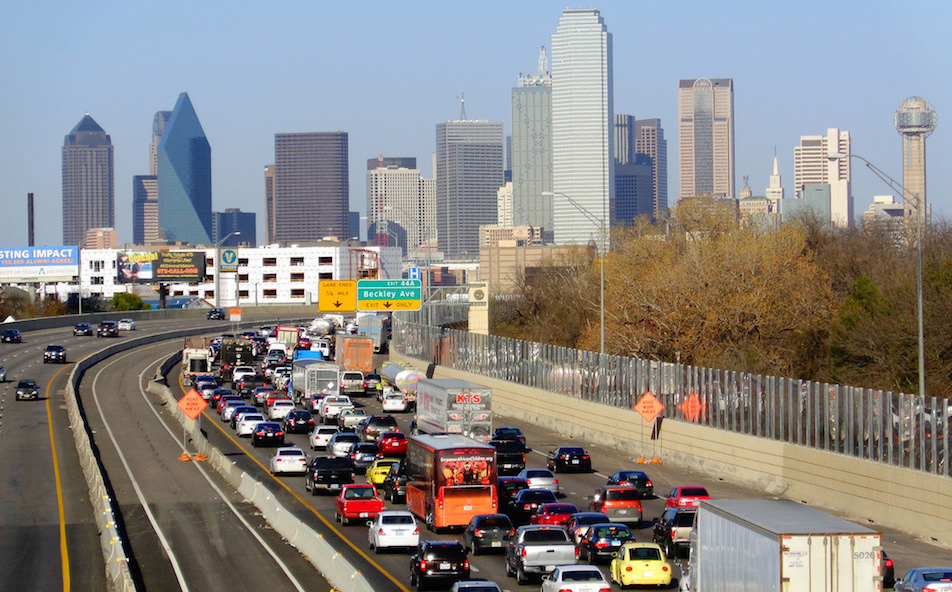By Randy Lee Loftis
Texas Climate News
When oil prices go down, climate questions come up.
Some people ask if cheaper oil means more driving and more emissions of climate-warming carbon dioxide. Others want to know if it means the magic is fading from our century-long affair with gasoline.
Still others wonder whether seemingly mysterious hikes and dips in oil prices mean much of anything over decades of climate concerns.
In Texas, some intriguing numbers on gasoline and driving might challenge some assumptions. More on that in a moment.
Gas prices had been stuck in low for a while, but they’ve gone up for three weeks, averaging $2.04 a gallon on March 28, AAA reported. A year ago, the average was $2.46.
Driving does go up when gasoline prices dip and retreats when they rise. But neither marks climate progress or the lack of it. That’s like thinking a cold snap disproves global warming. It’s the long-term average that matters.
Longer-term data on oil prices and the climate can support different and even contradictory arguments – “a glass that is both half full and half empty,” International Energy Agency chief economist Laszlo Varro told the U.K.-based website Carbon Brief in January.
Policy, not price, drives most investments in renewable energy that might replace fossil fuels, Varro said. Depressed oil prices might temporarily dampen enthusiasm for renewables investment.
However, low fossil fuel prices also lead to massive fossil investment cuts. Some projects that have already been cancelled were long-lifetime, high-carbon assets that would have been very problematic in later stages of decarbonization. Cancelling or delaying such projects offers an opportunity to steer energy demand in a permanently cleaner direction.
Last May, participants in a Council on Foreign Relations workshop on oil prices and climate policies reached some similar conclusions. Oil will generally be higher in the future, they said, but will still follow non-climate factors such as supply and demand, global economics and regional strife.
That means governments need climate strategies that look beyond today’s pump price, they agreed:
All that adds up to price swings that make it hard to know where oil prices will be next month, let alone next year. … Simply put, oil-market uncertainty – especially whiplash-inducing price spikes and busts – puts a premium on policymakers’ ability to establish clear and predictable policies that can serve, as it were, like oil on the water to smooth choppy seas.
Clear, consistent U.S. climate policies seem like a fool’s bet these days. Republican frontrunner Donald J. Trump is on record labelling global warming a hoax. Democrats Hillary Clinton and Bernie Sanders would support climate action, but almost certainly would run up against a Republican-controlled Congress, or at least a Republican-controlled House of Representatives.
Meanwhile, the Obama administration’s Clean Power Plan, which deals with power plant emissions, is on hold pending a decision by a Supreme Court with a vacancy that splits the justices 4-4 along ideological lines.
So what does this mean for Texas, where short-term oil price drops are an economic depressant and long-term climate planning by the state is, at present, politically impossible?
State figures shed light on hidden trends that bump up against some Texas stereotypes.
While Texas’ population rose by 18 percent from 2005-2014, revenues from the state’s motor fuels tax went up just 13 percent, to $3.3 billion. Nearly each year, the fuels tax’s share of the state’s total income has dropped.
That’s due in part to more fuel-efficient vehicles. The top-selling vehicle in Texas and the U.S. is Ford’s F-series pickup. A 2015 F-150 with a 6-cylinder, 2.7-liter engine and an automatic six-speed is rated at a combined city-highway 22 mpg. A decade ago, the equivalent model had a bigger engine and got a combined 15 mpg.
Gasoline is a prisoner of physics and chemistry; each gallon burned produces the same amount of CO2, regardless of the vehicle’s mpg rating. A gallon weighs just more than six pounds, but because its carbon hooks up with two oxygen molecules from the air intake, it produces about 19.64 pounds of CO2.
Even at the higher mpg, it doesn’t take long for a vehicle to emit its own weight in CO2. The 2015 F-150 does so every 4,538 miles (curb weight 4,051 pounds divided by CO2 at 19.64 pounds/gallon equals 206 gallons of gas. Gallons multiplied by 22 mpg equals 4,538 miles).
Annual vehicle-miles traveled, the measurement of how much a population drives, also has lagged behind Texas’ population growth. In 2005, according to the Texas Department of Transportation’s raw numbers, Texans drove an estimated 234 billion miles. The 2014 estimate was 249 billion, a 6 percent increase, just a third of the population-growth rate in that same period.
Does this mark a huge change in Texas? Maybe. Perhaps all those independent entrepreneurs working at home or at Starbucks are making a difference. Maybe downtown infill housing is moving the needle. Maybe people are just tired of sitting in traffic jams.
Whatever the answer, something more than today’s pump price is in play.
+++++
Randy Lee Loftis, an independent journalist in Dallas, is senior editor of Texas Climate News.

